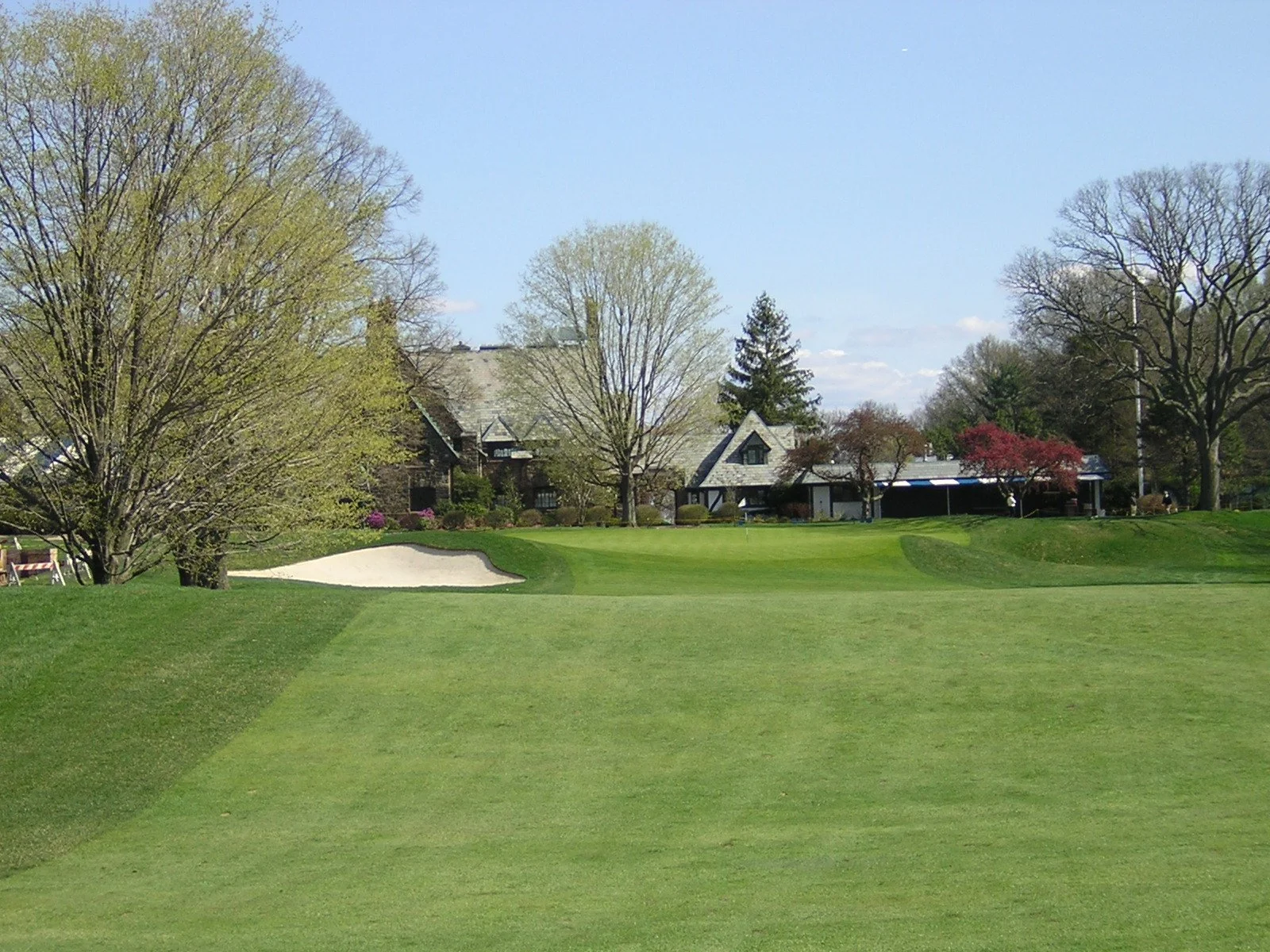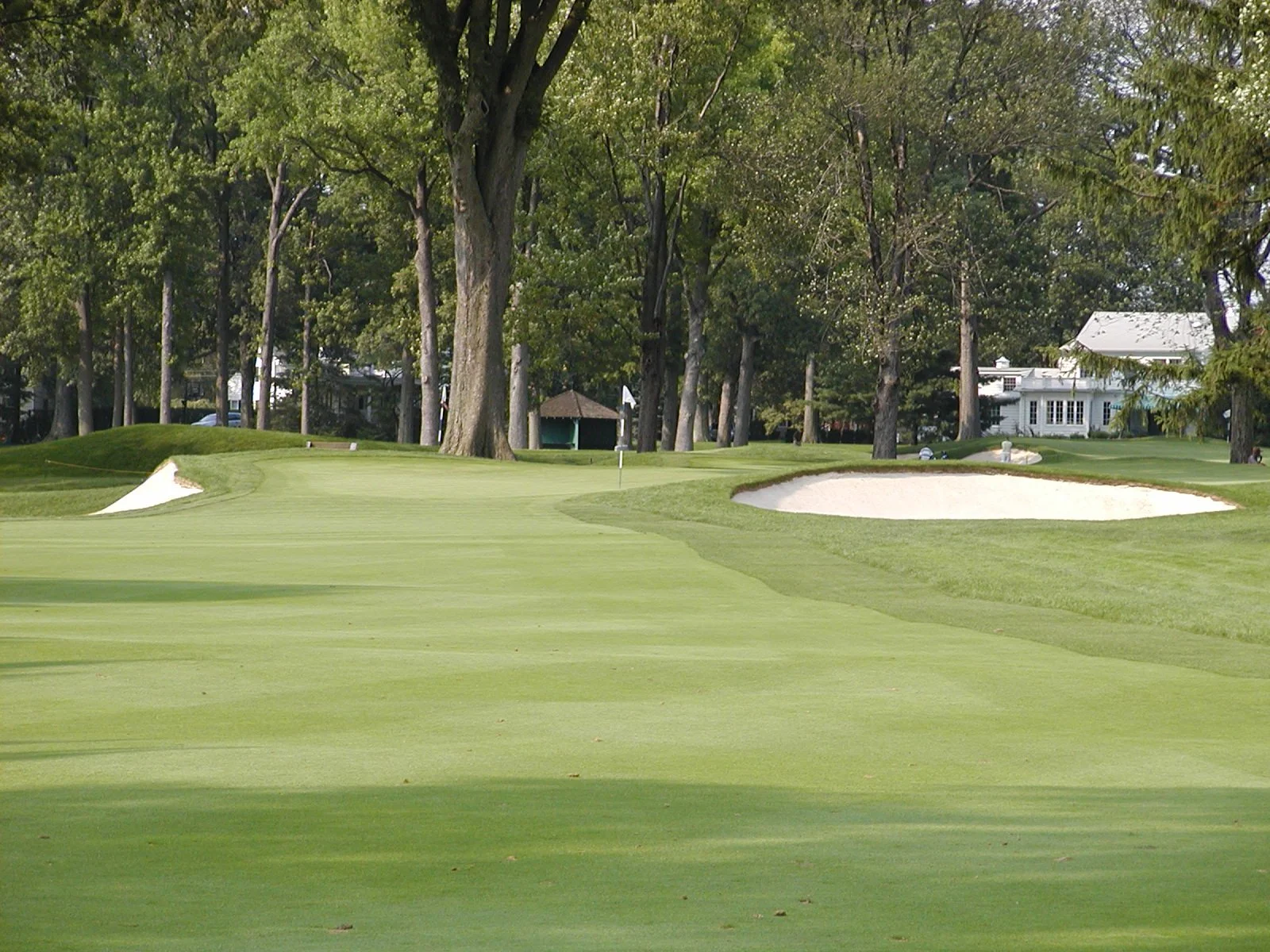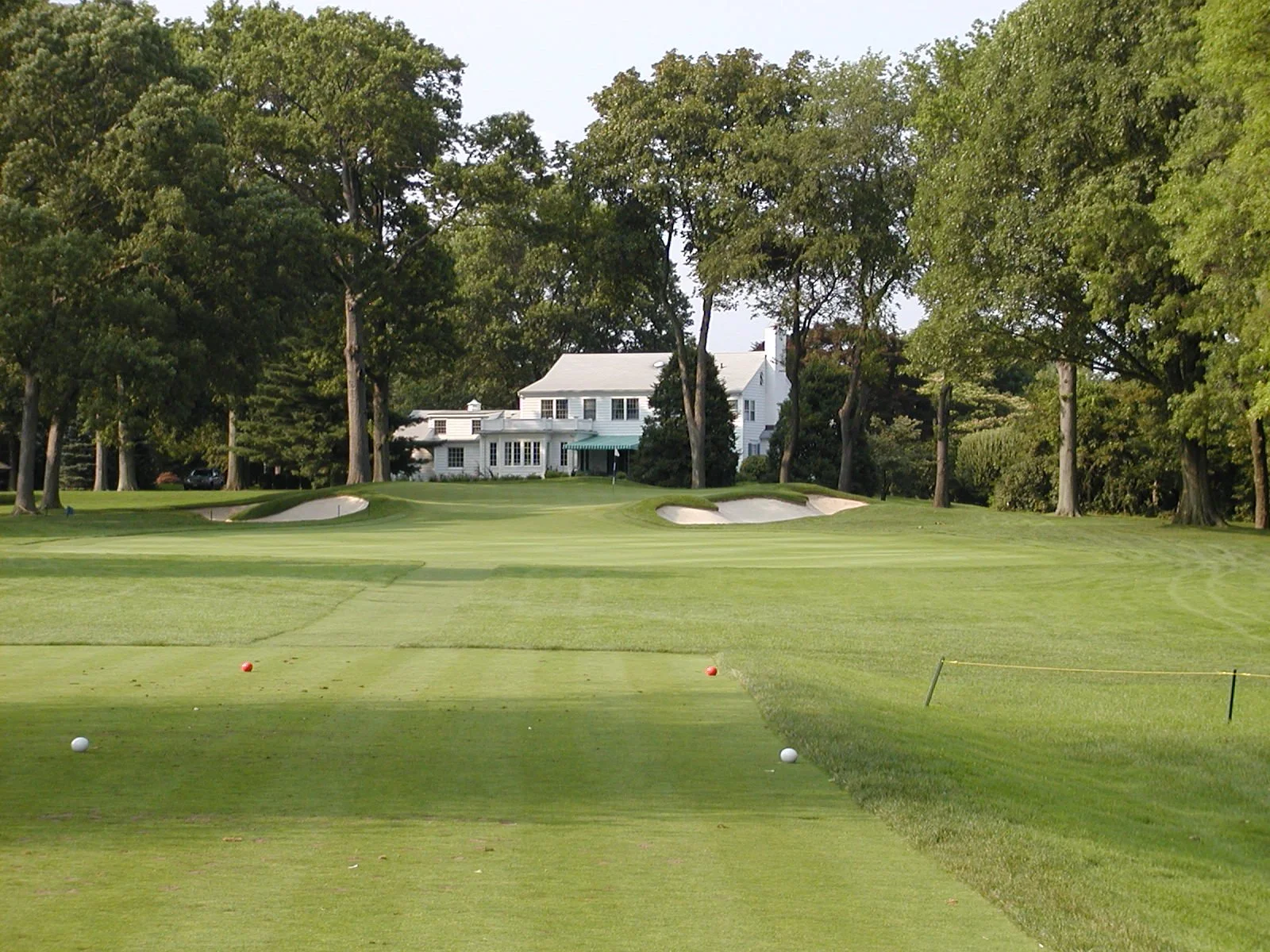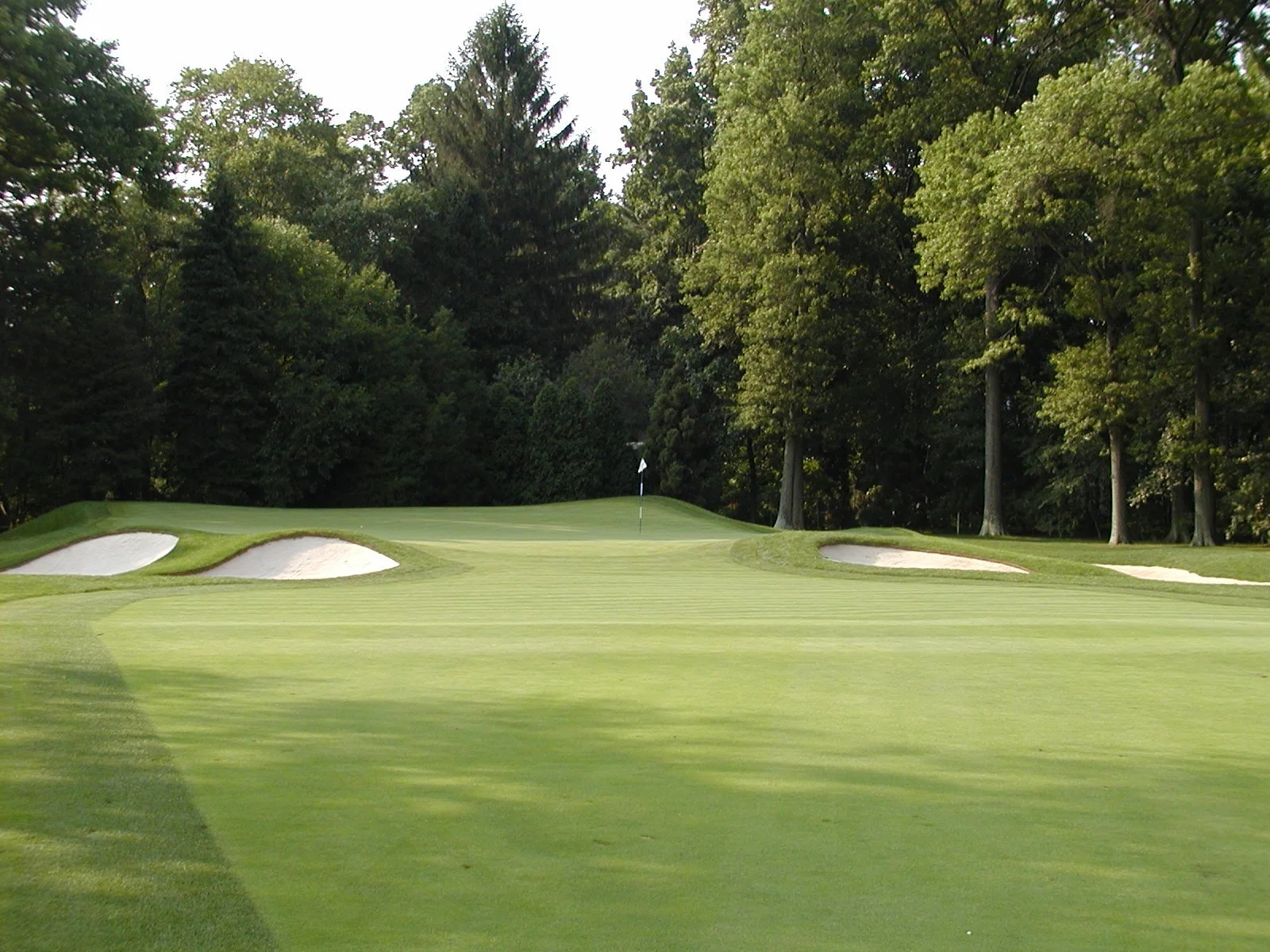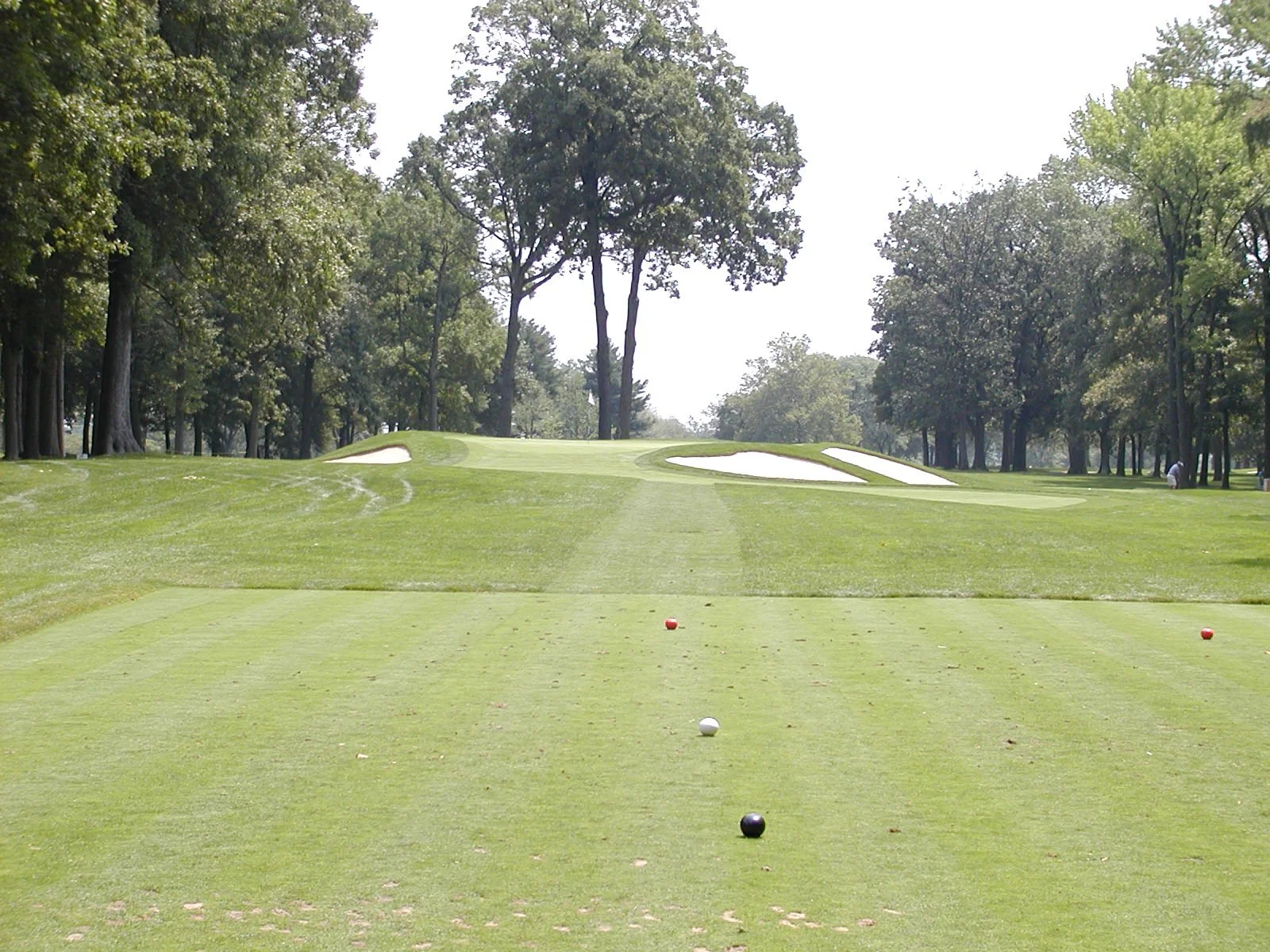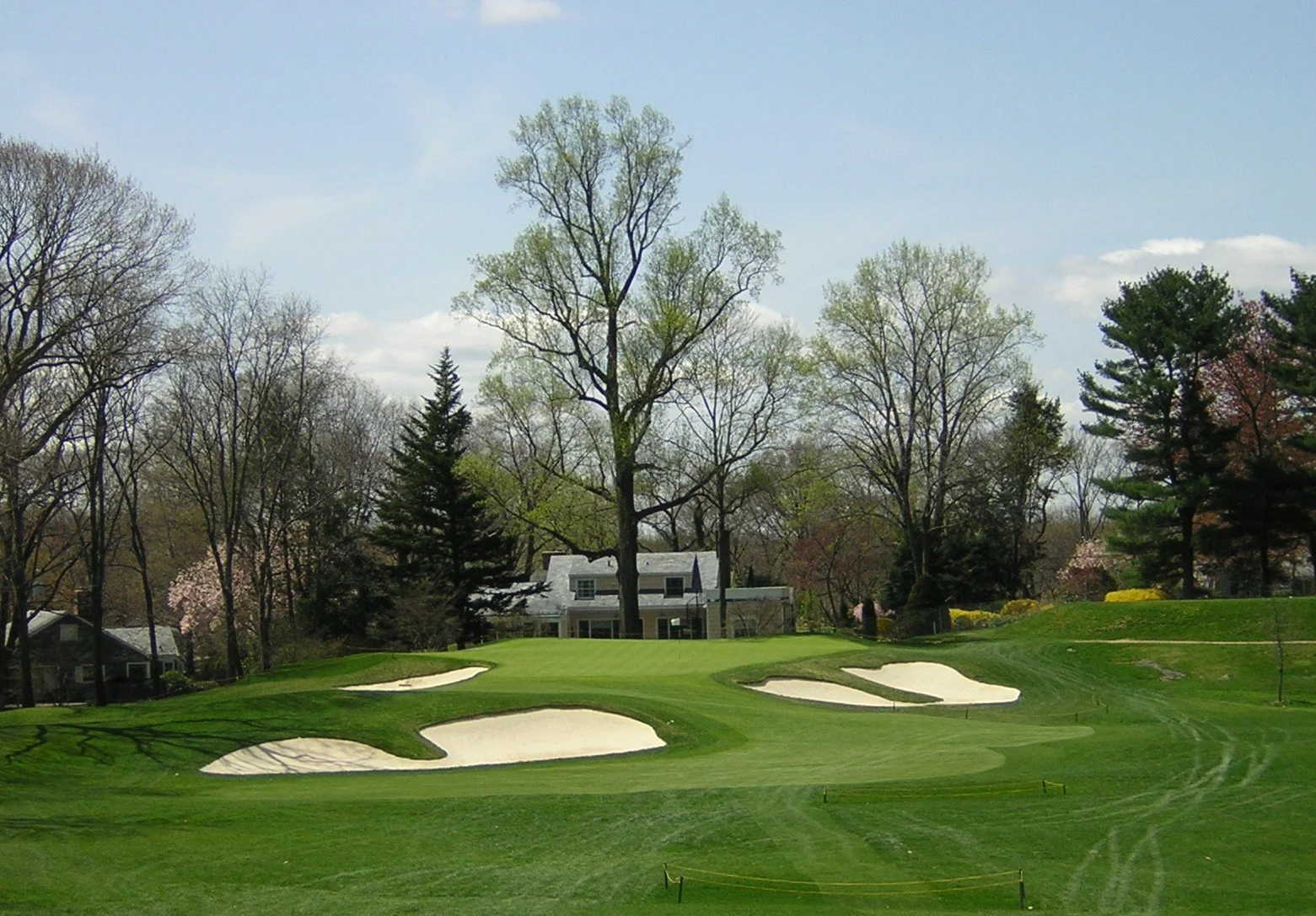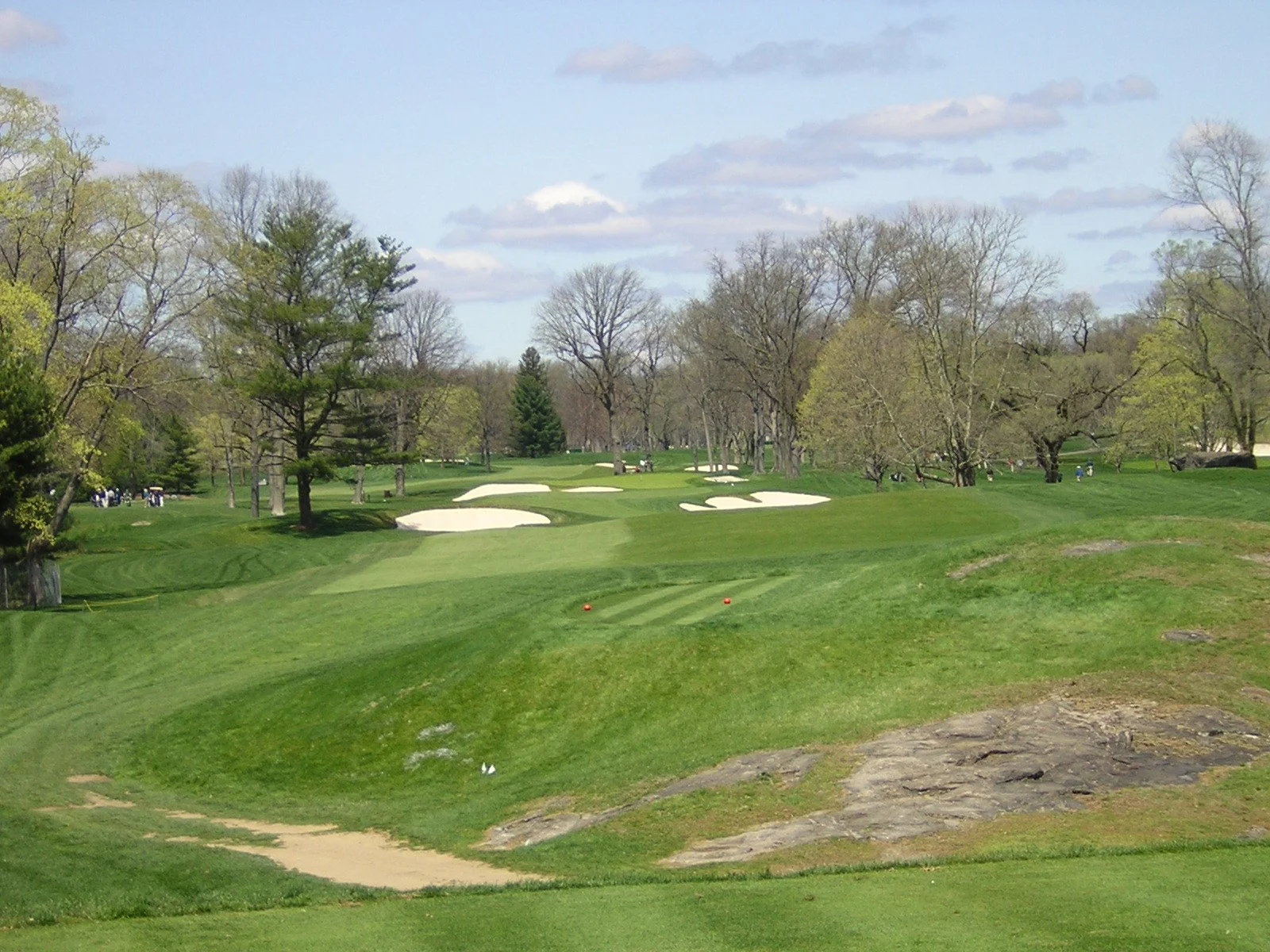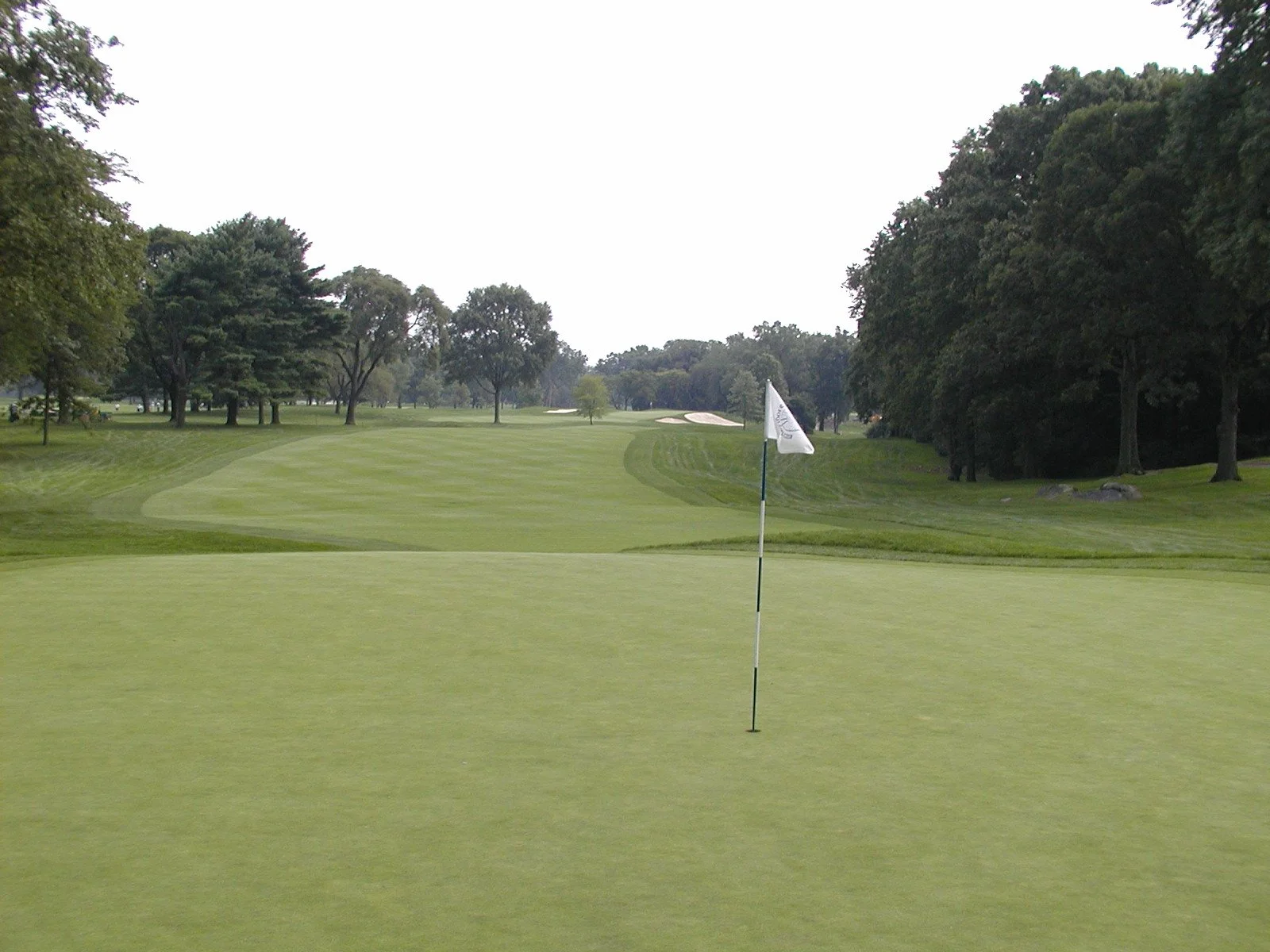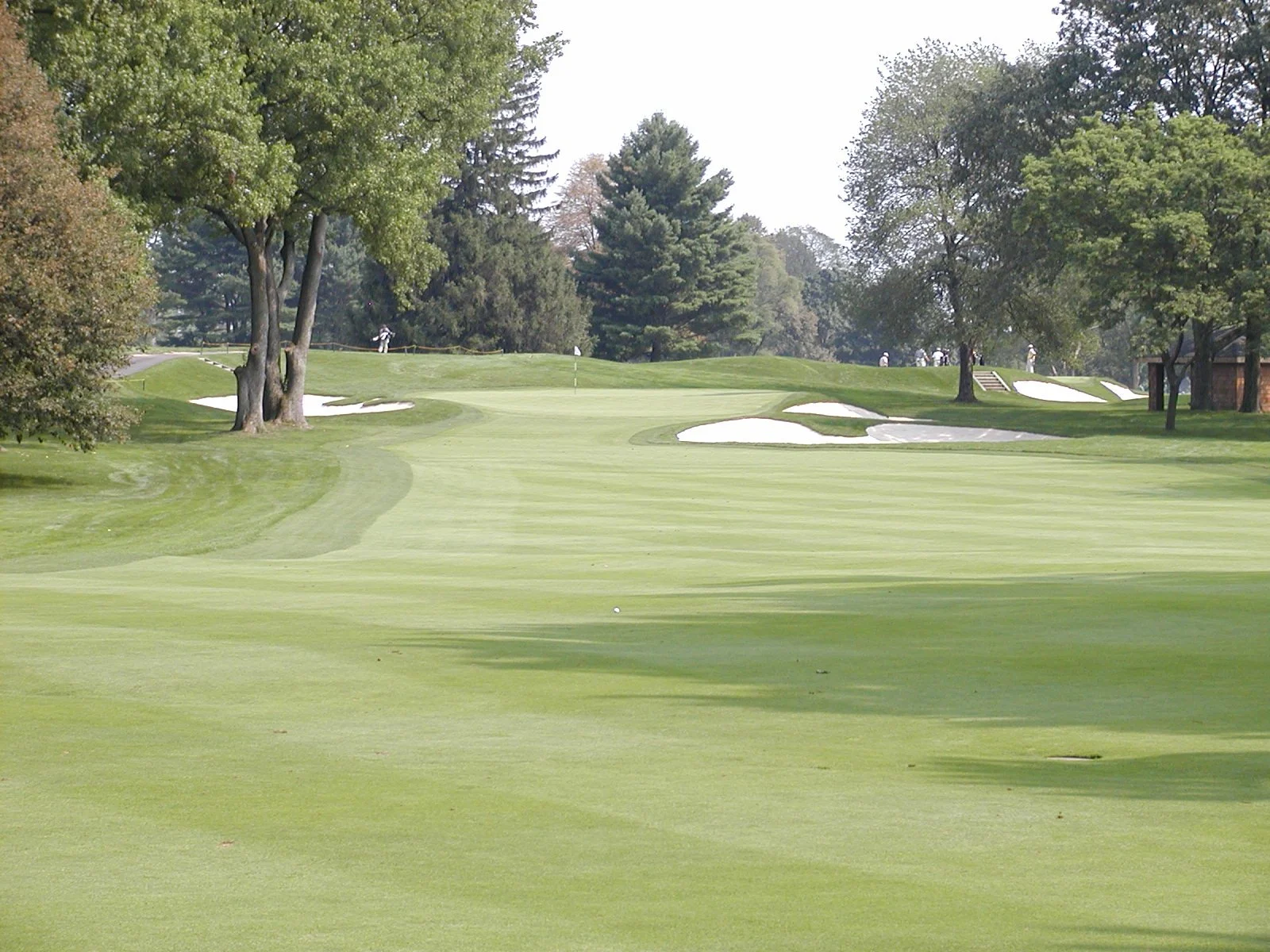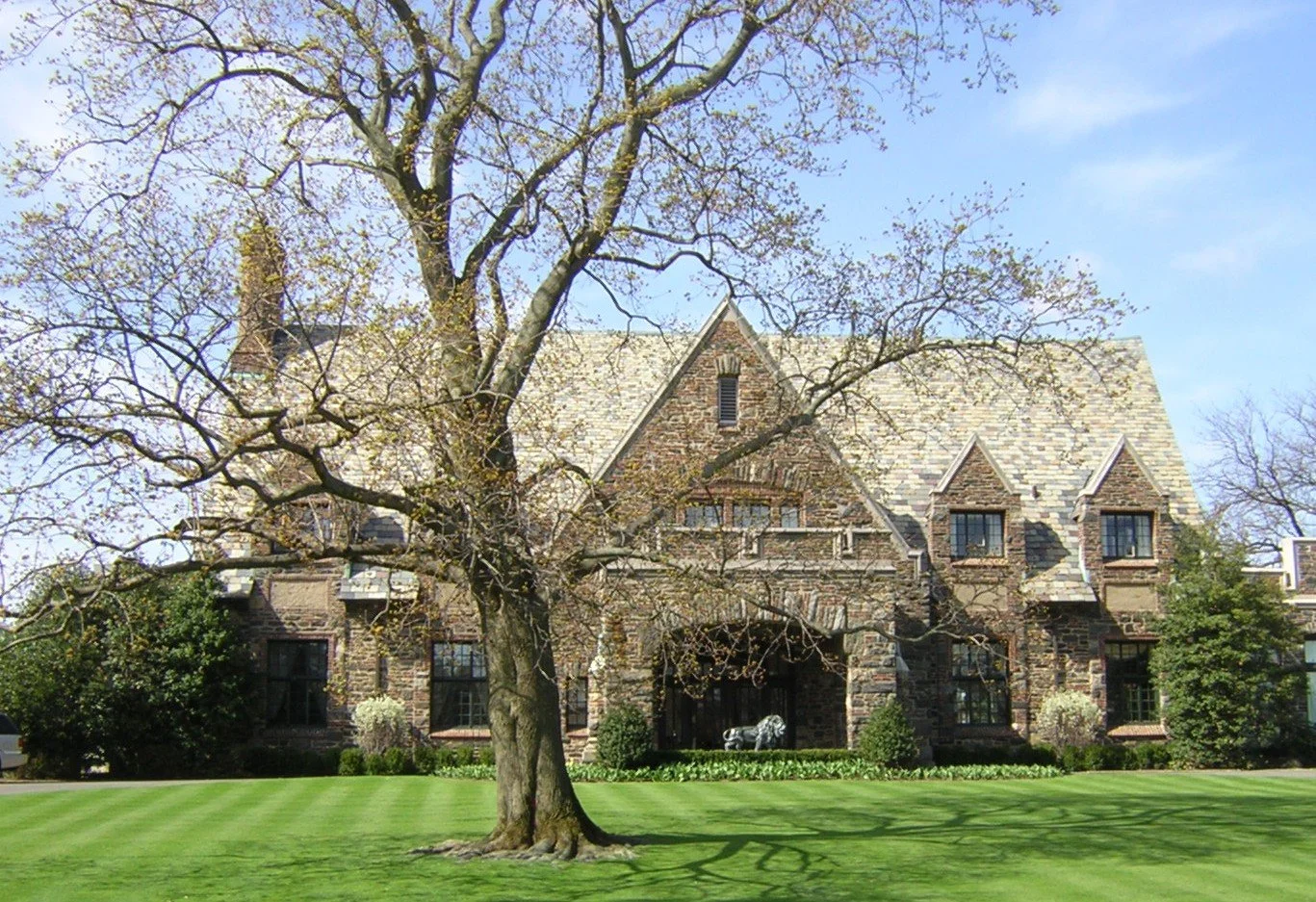WINGED FOOT GOLF CLUB (WEST COURSE)
Course Architect(s): A.W. Tillinghast (1923), George & Tom Fazio, Tom Marzolf (1984), Gil Hanse & Jim Wagner (2016-17, renovation)
Year Opened: 1923
Location: Mamaroneck, New York
Slope: 140. Rating: 76.4
Par: 70
Yardage: 7,477
Hole-by-Hole: 1 - Par 4 451 Yds 10 - Par 3 214 Yds
2 - Par 4 484 Yds 11 - Par 4 384 Yds
3 - Par 3 243 Yds 12 - Par 5 633 Yds
4 - Par 4 467 Yds 13 - Par 3 212 Yds
5 - Par 4 502 Yds 14 - Par 4 452 Yds
6 - Par 4 321 Yds 15 - Par 4 426 Yds
7 - Par 3 162 Yds 16 - Par 4 498 Yds
8 - Par 4 490 Yds 17 - Par 4 504 Yds
9 - Par 5 565 Yds 18 - Par 4 469 Yds
Par 35 3,685 Yds Par 35 3,792 Yds
Events Held: U.S. Open (1929, 1959, 1974, 1984, 2006, 2020, 2028),
U.S. Women's Open (1957, 1972 - East Course),
U.S. Senior Open (1980 - East Course),
U.S. Amateur (1940, 2004),
Walker Cup (1949),
PGA Championship (1997).
Awards Won: Ranked 4th by Golf Digest's Best in State Rankings (NY),
Ranked 14th by Golf Digest's America's Greatest Courses (2025-26),
Ranked 16th by Golf Magazine Top-100 Courses in the U.S. (2005),
Ranked 16th by Golfweek's Top-100 Classic Courses (2004),
47th by Golf Connoisseur.com Most Prestigiuous Private Clubs in America (2006).
HISTORY: There are only a few courses in the United States with more history than Winged Foot Golf Club. First up, the architect, A.W. Tillinghast, who designed such gems as Quaker Ridge, Baltusrol, San Francisco Golf Club and Somerset Hills, all of which rank in the top-100 in America along with both of his courses at Winged Foot. Tillinghast was told to build a man-sized course on the 280 acres purchased by several members of the New York Athletic Club. Instead, he built two. Next, the marquee events that have been staged at the club. U.S. Opens, Women's Opens, Senior Open, the Walker Cup and the PGA Championship, to name a few. As golf analyst Jim Nantz once commented, "Where great history has been made."
How about where the term "Mulligan" was invented. For all us hackers, this could be the best. It seems in 1937, an Irishman named David Mulligan joined the club. He was noted as a slow starter and when his opening tee shot would scurry any which way, he would reload a second. His friends called this shot a "Mulligan."
Just six years after the course opened, the U.S. Open was held on the West Course and the immortal one, Robert T. Jones, Jr. won by a whopping 23 shots in a playoff over Al Espinosa. I might add that Jones needed a 12- foot par putt on the final hole of regulation just to reach the playoff after making a pair of sevens during the final round.
When the Open returned in '59, it was Billy Casper who hoisted the U.S. Open Championship Cup, as he defeated Bob Rosburg by one shot. During the 72 holes, Casper three-putted only once, at the 10th hole. Host professional Claude Harmon finished two shots behind along with Mike Souchak. It must be noted that Harmon holds the course record on both courses with a pair of 61s. The interesting story behind Harmon's 61 on the West Course is that he shot it while listening to the World Series on the radio. The competitive course mark is 65 set in 1997 by Justin Leonard and Jeff Maggert at the PGA Championship.
Fifteen years passed and the Open returned to New York for what sportswriter Dick Schaap coined, "The Massacre at Winged Foot," as Hale Irwin's winning score was seven over par. Irwin, who recorded the first of his three U.S. Open titles, defeated Forrest Fezler by two shots. His score was the highest in relation to par since 1963 when a score of nine above par tied after 72 holes and caused a playoff. Tied with Fezler with just two holes remaining, Irwin, playing in the group behind, saved par from 10 feet while Fezler made bogey on the last for the margin of victory. Arnold Palmer, contending for one of the last times in the Open only three back heading into the final round, was
leading after four, but shot 76 and tied for fifth. During the opening round, no player broke par and only South African Gary Player was able to shoot an even-par 70. USGA stalwart Frank "Sandy" Tatum was asked if the organization was trying to embarrass the best players in the world. His response was quite simple, " No. We're trying to identify them."
When the Championship returned 10 years later, Palmer once again made some noise, but this time his streak of consecutive U.S. Opens ended at 31, as he failed to qualify for the event. For the first time in all of the previous Opens at Winged Foot, someone, or should I say "some ones" broke par, as both Fuzzy Zoeller and Greg Norman finished regulation at four- under-par. Former champion Irwin led after three rounds, but faded on the final day as Zoeller and Norman moved clear of the field. Zoeller led by three strokes with nine holes to play, but Norman pulled even at the 17th and saved par on the 18th by holing a 45-foot putt after hitting his approach into a grandstand and being given relief without penalty. After making the putt, Zoeller, in the middle of the final fairway, began waving his towel in surrender having thought Norman made the long putt for birdie. During the playoff, Zoeller returned the favor on the second hole, making a 68-footer for birdie while Norman made double-bogey and the rout was on. Zoeller would win by eight shots with Norman waving his towel in defeat coming down the final fairway.
When the U.S. Amateur was held on the West Course in 1940 for the first time, Winged Foot member Richard D. Chapman posted one of the largest margins of victory, as he crushed W.B. McCullough, Jr., 11 & 9. To this day, Chapman remains as the only member of the host club to have won this event since World War I.
The 2004 U.S. Amateur proved to be quite amazing as Ryan Moore won the last four holes, three by birdie to defeat Luke List, 2-up. Moore is only the fifth player in history to capture two USGA events in the same year. Moore, the 2004 NCAA Division I champion and current PGA professional, also captured the 2004 U.S. Amateur Public Links title. During the stroke play portion of the event, only two players in the 312 player field shot par or better on the famed West Course, the longest in U.S. Amateur history. THe ninth hole proved to be the most difficult with a scoring average of 4.80.
The most historic or symbolic triumph at Winged Foot, however, might be the 1997 PGA Championship, in which Davis Love III out-dueled Justin Leonard down the stretch to capture his only major title. Trailing by one shot after two rounds, Love was brilliant over the final 36 holes, shooting back-to-back 66s for a five-shot win over Leonard. Love's winning total of 11-under par was the lowest of any champion at this storied venue. Love capped off the win with a 15-foot, right-to-left breaking putt in the center of the final hole with a rainbow overhead. The victory was quite emotional for Love, whose father, a respected PGA Professional, died in a plane crash in 1988.
The USGA returned to Winged Foot Golf Club for the 106th U.S. Openin 2006. With just three holes remaining, Phil Mickelson was in the lead by two over Australian Geoff Ogilvy. One small problem, Mickelson was struggling off the tee and his bid for a third straight major championship was in question. Looking to become just the third player ever to win three consecutive majors, Mickelson hit only 2-of-14 fairways in his final round. His last two misses were bizarre: into a trash can at the 17th hole, and off a large, white tent at the 18th.
Despite making par on 17 to hold a one-shot advantage into 18, Mickelson played the final hole with driver in hand. After his tee shot bounced off the tent and into the left rough, the lefthanded Mickelson tried to hit a big slice around a group of trees. But he hit one of the trees, and the ball landed just 25 yards further up. His third shot stuck deep in a greenside bunker and his fourth rolled over the green into the rough on the other side. A miracle 30-foot chip for bogey would have forced a playoff, but Mickelson skipped the shot past the hole and ended with his only double-bogey of the tournament.
Ogilvy, on the other hand, was playing in the group ahead of Mickelson. From the left rough around the 17th green, Ogilvy chipped down the slope and into the hole for an improbable par save and then from a divot in the fairway on 18, Ogilvy saved par to finish at plus-five. Ogilvy's five-over-par 285 winning score was the highest since Hale Irwin's seven-over at Winged Foot in 1974.
Mickelson was not alone in his struggles, as Colin Montgomerie and Jim Furyk both wasted chances. Montgomerie made double-bogey on the last from the middle of the fairway, while Furyk, the 2004 U.S. Open champion, missed from four feet on the last. With the win, Ogilvy became the first Aussie to capture the U.S. Open since David Graham accomplished the feat in 1981.
Despite the pandemic, the U.S. Open was staged again at Winged Foot, but later in the season in the month of September. Justin Thomas held the first round lead after a five-under 65. Round two saw Patrick Reed take the lead by one over Bryson DeChambeau and by two over three players, including Thomas.
After a third-round 65, Matthew Wolff took the lead by two over DeChambeau and by three over Louis Oosthuizen. Under blustery conditions during the final round, DeChambeau carded a brilliant 67 to post a six-shot win over Wolff, who was 10 shots higher than the round before. With the win, DeChambeau became the 12th player to win both the U.S. Amateur and the U.S. Open. He finished as the only player under par at six-under. For the week, Winged Foot West proved to be quite difficult, playing to a scoring average of 74.010, with no one in the field posting a bogey-free round during the four days of play. DeChambeau also became just the third player in history to win the U.S. Open, U.S. Amateur and the NCAA Division I individual title, joining Jack Nicklaus and Tiger Woods.
Winged Foot Golf Club is the only facility in the United States to have both its courses ranked in the top-100, quite an impressive feat. The West Course is ranked 13th, while the East Course is slated in 45th spot. Both courses are ranked in the top-8 in the state of New York!
REVIEW: This is one course that does not start out innocently enough, as the first four holes are monsters right out of the box. The opening hole is 451 yards from the tips and the first of 10 par-fours over 400 yards. Bending to the left, a shaped tee shot is needed to remain in the fairway, which is just 28 yards wide. As you'll find out throughout the round, the rough at Winged Foot is gnarly and thick and must be avoided. A medium to long iron is required for your second shot to a green that slopes from back to front five feet. Below the hole is key to make par. That's right, don't think birdie here.
A new tee was added for future championships on the second, stretching it an additional 45 yards. This time, the hole doglegs to the right, with trees flanking both sides of the landing area. Favor the left side to get a better look at the raised putting surface. Two deep bunkers, left and right guard
your approach with a long iron or fairway metal. A very difficult green that rises from front to back with an intimidating American Elm standing guard over the left portion of the surface. A right pin placement behind the trap will be virtually impossible for players to get close.
How difficult is the par-three third hole? When Billy Casper won the 1959 U.S. Open, he purposely played short of the green all four rounds and ended up making par on each occasion. The object is to hit a long iron or fairway metal 243 yards to a green that's a 100-foot long, two-tiered putting surface with menacing bunkers left and right. No problem...yeah, right!
It doesn't get easier on the fourth tee. A dogleg left, the tee shot must carry the right corner of the left fairway bunker to have any chance of getting home in two. If successful, a medium iron will be your next play. The green is slightly elevated and sloping from back to front with sand guarding left and right. Former club pro and Masters champion Claude Harmon commented that all putts on this green broke towards New York City. They do!
Now it's time to make up some ground. Another massive par four, the fifth is 502 yards and doglegs to the left. A draw around the left corner will set up a long iron or fairway metal to a well protected green. The putting surface slopes back to front, so stay below the hole for a birdie chance. The best play would be to lay up short of the green and use your wedge game to get it close.
The difficulty of the sixth is certainly not the length. Accuracy is king here, as a long iron off the tee needs to split the tree-lined fairway, setting up a wedge to a slick green. However, at just 321 yards, the big stick is not a bad play either in an attempt to reach the green. The L-shaped putting surface slopes from back to front and right to left with sand left and right-center. A back-right pin can be quite devilish.
Missing the green on the par three seventh will result in bogey, it's that simple. It's only 162 yards, but plays uphill to a long green that's protected on both sides by deep bunkers. The putting surface slopes back to front, so below the hole is your best chance at birdie. Back left and front right are the most difficult pin placements.
A new tee, a dogleg right and 490 yards of a brutal par-four, the hardest hole on the front side, the eighth requires a tee shot that hugs the right side of the tree-lined fairway to at least leave long iron to the green. The putting surface tilts to the left, so missing right will be a disaster. Bunkers protect both sides of the green, just ask Bobby Jones. In 1929 Jones blasted from one bunker to another and then back again resulting in triple-bogey seven.
Grip it and rip it. That's the motto on the ninth, one of the few straight holes on the course. The members play it as a three- shotter, but for championship events, well good luck. Not only is a big drive required, as 42 yards have been added to the hole, but accuracy is important, as thick rough lines the fairway. The putting surface is surrounded by five bunkers and features a large hump down the center. This is survival at its best.
The back nine opens with Winged Foot's signature hole and one of the world's greatest par-threes. Even the architect called it "my finest par- three." This one shotter requires a five to seven-iron, but precision is a must, as the elevated surface is flanked by sand. The green slopes from back left to front right, so do not miss left and long. When Ben Hogan played in the 1959 U.S. Open, he called this "a three-iron into some guy's bedroom."
A long iron or fairway metal is needed off the 11th tee. Just 384 yards, this par-four is a birdie possibility, as a short iron should remain for your second shot. The green slopes left to right and back to front quite severely, so once again, stay below the hole. During the 1984 Open, Curtis Strange hit a five-iron into the wind for his second shot and slammed dunked it for an eagle two. Even with the deuce, Strange finished a distant third, five shots back.
I'll say it first, there is no way anyone will reach the par-five 12th in two. At 633 yards, this is a true three-shot hole. Play down the right side of the fairway off the tee to set up a clear shot to the landing area short of the green. Missing left when laying up will leave yourself in a group of trees,
while sand awaits on the right. Following a successful second, a short pitch will remain to a green that's flat in the front but rises to a second tier in the back. Any pin location back or left will prove to be the most difficult. By the way, at the 2004 U.S. Amateur, current PGA Tour player J.B. Holmes knocked it on in two, so I stand corrected.
Another outstanding par-three, the 13th requires a long iron or fairway metal to a slightly elevated green. Bunkers left and right protect the sloped putting surface, which features a couple of tiers. If played incorrectly, putting on this green could end up being a roller coaster ride. Can you imagine making birdie here, not likely.
If you thought the first 13 holes were tough, as they say, you ain't seen nothin' yet. The final five holes are all par-fours of over 400 yards in length. A dogleg left of 452 yards starts the quintet. A drive over the corner of the "shamrock" bunker is needed to leave a medium iron for your second. Four bunkers protect possibly the easiest green on the course. Most players will lean heavily on their short game to make par here.
Driver is not needed on the downhill, par-four 15th, but accuracy sure is, as sand right and trees left will play havoc on your tee shot. The fairway tilts from right to left, so anything hit off line will surely end up in the rough. A small stream at the bottom of the hill will capture any greedy player's tee ball. Your approach shot is uphill to a long, narrow green guarded by sand. The two-tiered putting surface slopes six feet from back to front, making a two-putt almost impossible.
The members play the 16th as a par-five, but not in championship play. It's only 498 yards, but requires a pinpoint drive past the dogleg left into a landing area just 28 yards wide. From there a long iron awaits to a difficult two-tiered green that slopes from back to front.
The 17th and 18th holes could be the best finish of any course in the world. A stern test, the 17th requires a strong tee shot that favors the left side, as the fairway slopes to the right. Trees stand guard down both sides of the landing zone, so accuracy is a must. The putting surface is quite slick from
back to front with bunkers protecting almost every angle of the green. Jack Nicklaus described this hole as one of the great par-fours of the world, "it is one of those textbook tests of golf - a hole that pits the player against the designer."
You will be hard pressed to find a better feeling in golf than walking up the 18th fairway at Winged Foot West. If you don't have goose bumps as you make the turn left and see the clubhouse in the background and remember Love's PGA win or any of the other amazing moments, then you're without a pulse. The hole itself is quite daunting, as the fairway features many small hills and swales,
not to mention sand right and thick rough left. But the most difficult part of the 18th is the green. The putting surface has two tiers, slopes from the back and has a false front. Any shot landing on the front edge will roll back down the fairway. After holing out, just look back and take it all in and smile.
OVERALL: Winged Foot Golf Club is a special place. From the magnificent clubhouse, the historical significance, impeccable conditions, courteous staff, knowledgeable caddies and the amazing and challenging course, not many venues in America stand ahead of Winged Foot.
The clubhouse was built out of the stone and rock that was blasted from the fairways in building the courses and was designed by Clifford Charles Wendehack, who crafted some of the finest clubhouses in the world.
Over the years, Tom Fazio was brought in to rebuild bunkers and tees, add length and take out trees. The rough was completely re-done and is now amazingly uniform throughout the course. Prior to the U.S. Open in 2020, Gil Hanse was hired to renovate and restore the West Course. Hanse focused on recreating the original green shapes, sizes and slopes. In addition, the same was done to the bunkers and fairway lines. New back tees were added for more length and variety to challenge the players of today.
When playing the course, there are three don'ts at Winged Foot. Don't hit it in the rough. Don't short side yourself on the greens and don't putt from above the hole. Even if you succeed in accomplishing these tasks, you still might not break 80.
To be picky, only two items standout. The driving range is too small and cannot accommodate hitting the big sticks, and if you are not familiar with both courses then you might get lost, as the East and West Courses have holes that intertwine with each other.
Saying that, I would play here over and over again. I can't wait to return.

